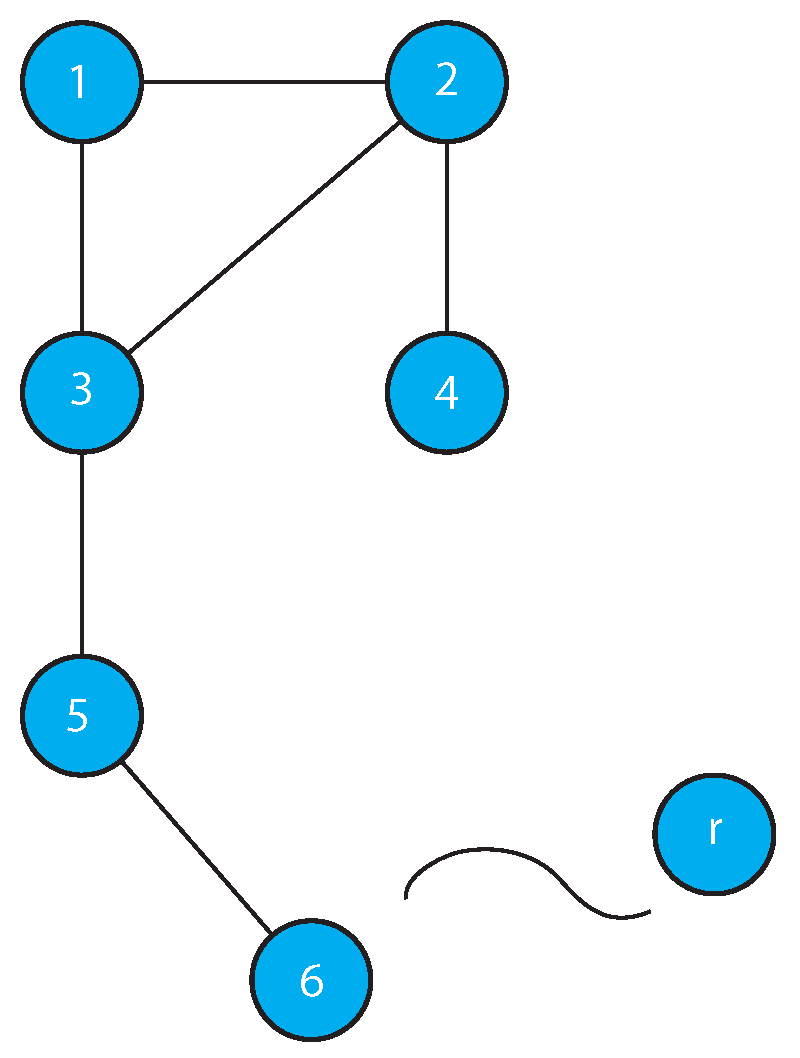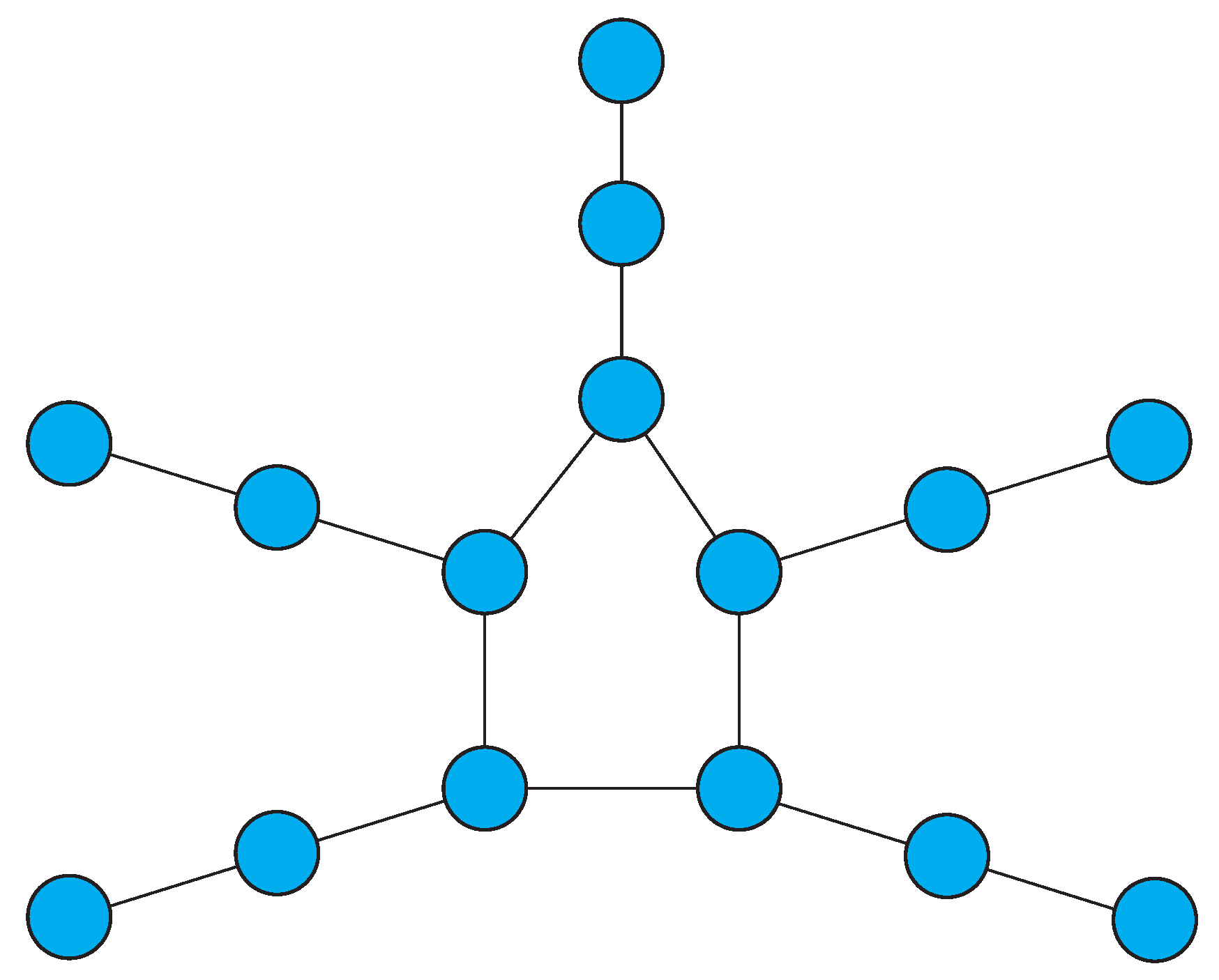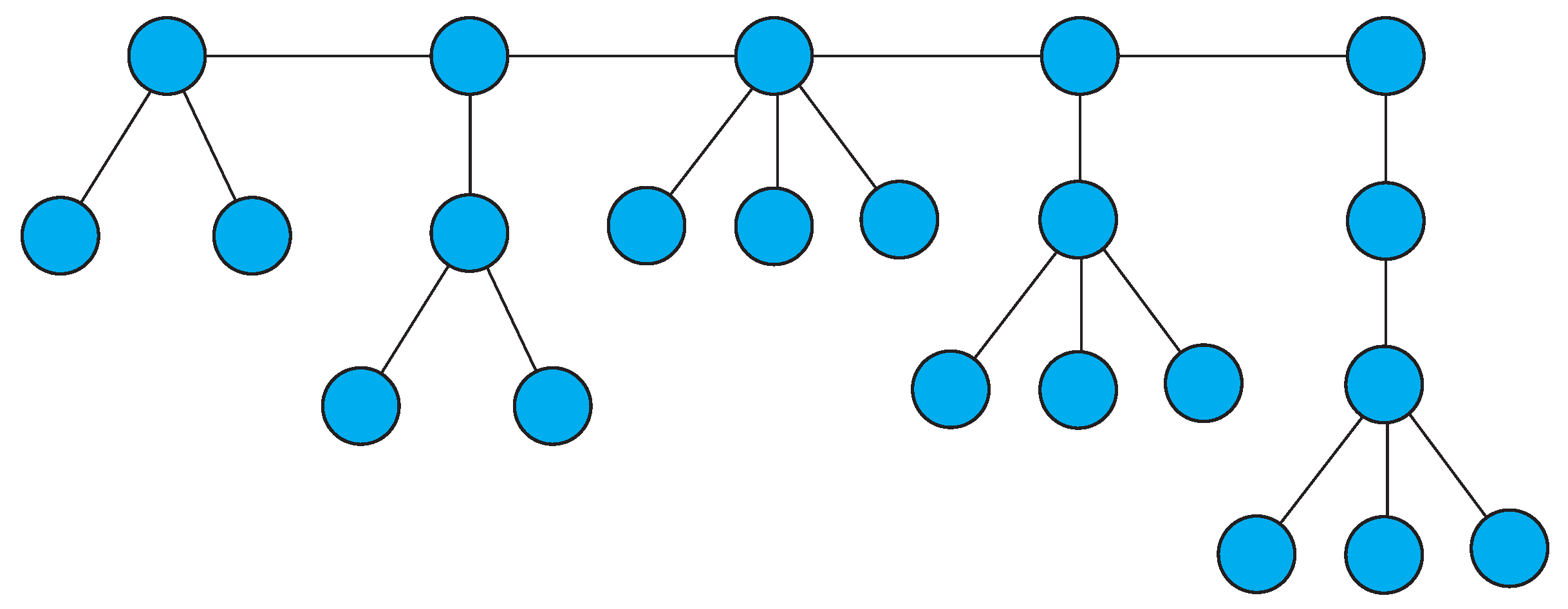1. Introduction
Quantitative measures of graph complexity, defined in terms of Shannon entropy, are typically based on a partition of the vertices or edges of a graph. One such partition of the vertices of a graph is related to symmetry structure. In this paper, we reverse the order of things and start by asking “is there a graph with a given entropy value”, which translates into “is there a graph whose symmetry structure produces a partition giving that entropy value”.
It has long been known that any partition of a positive integer can be realized as the orbit structure of the automorphism group of a weakly connected directed graph [
1]. This structure provides the basis for certain quantitative measures of graph complexity. In particular, the set of orbits constitutes a partition of the vertices of a graph, thus defining an equivalence relation. An information theoretic measure based on this equivalence relation has been elaborated and refined as an index of graph complexity, see [
2,
3] for an overview. This is an example of a topological graph measure based on the automorphism group of a graph, and many such measures have been developed [
4,
5,
6]. Investigations of the structural complexity of graphs and networks [
7] have figured prominently in such development. Vertices in the same orbit are similar under graph automorphism and thus share many graph-theoretical properties [
8]. Most of these measures depend on determining vertex or edge orbits [
4,
6]. Since automorphisms are permutations of the vertices that preserve adjacencies, a brute force approach, examining all
permutations is not feasible. See [
9,
10] for discussion of orbit computation methods and heuristics.
This note focuses on the question of whether or not a given partition of a positive integer can be realized as the orbit sizes of the automorphism group of some graph. In particular, we present a proof of the existence of connected, undirected graphs whose automorphism groups have prescribed orbit structure. The proof proceeds by explicitly constructing the graphs in question. The component graphs in this construction are shown to have a minimal number of edges, and a special class of trees with prescribed orbit structures is also produced. The methods developed here can be used to construct graphs with an explicit degree of symmetry. In addition, the graphs so constructed can be used to calculate and interpret existing symmetry measures, see [
4,
5,
6].
Most of the graph theoretic definitions needed for subsequent sections are given here; specialized definitions are introduced as needed. The terminology and notation is standard, see for example [
11] for further details. An
undirected graph consists of a set
of
vertices and a set
of unordered pairs of vertices called
edges. An edge
has the form
for vertices
,
;
u and
v are said to be
adjacent in
G. Thus, the graphs considered here have no loops, (i.e, edges of the form
), and no parallel edges.
The degree of a vertex is the number of vertices to which it is adjacent. An edge is said to be incident to u and v. A path with n vertices is a sequence of edges in which and , and and have no vertex in common. The length of is , the number of edges contained in it. If and are both incident to a common vertex, the sequence defines a cycle with vertices and edges. A subgraph of a graph is defined by and such that every edge in F is incident to vertices in U. A graph G is said to be connected if there is path between every pair of distinct vertices in G. If a graph G is not connected, it is said to be disconnected and consists of two or more connected subgraphs called components. A tree is a connected undirected graph with no cycles. The complete graph on n vertices, denoted by , contains all the pairs of distinct vertices in its edge set. The complement of a graph G, denoted by , has vertex set V and edge set consisting of all the unordered pairs ( and ), not in E, i.e., . Two graphs and are isomorphic if there is a bijection mapping U to V such that for any with , . An automorphism of a graph G is an isomorphism of G to itself. The collection of automorphisms forms a group under composition. Vertices u and v are said to be similar if there exists an automorphism mapping u to v. An orbit of is the set of all vertices similar to a given vertex. The collection of orbits constitutes a partition of V. A graph G whose automorphism group consists of the identity alone is called an identity graph.
2. Existence Theorem
Theorem 1. Let n be a positive integer such that , for some positive integer t, where is the number of values equal to i in the sum. If or , then there exists an undirected, connected graph G whose automorphism group has t orbits of sizes , respectively.
Proof. The proof is by construction. First, we show how to form a disconnected, undirected graph H with the requisite orbit structure. The constructed graph H consists of disjoint, non-isomorphic subgraphs, each of which contributes a unique orbit to the automorphism group . The complement is then the desired result, since it is connected and has the same orbit structure as H. This follows from the well known facts that (1) the complement of a disconnected graph is connected, and (2) is the same as .
If
, there is no need for an orbit of size 1 in
H; if
, a single isolated vertex in
H supplies the necessary orbit of size 1. Now, if
, the component constructed as shown in
Figure 1 (by attaching
vertices successively starting at vertex 6 and continuing with each added vertex) has
orbits of size 1. Note that the graph in
Figure 1 consisting of six vertices is the smallest connected graph with an identity group. This is well known and can easily be confirmed by examining the relatively small set of undirected graphs with between 2 and 5 vertices. The construction (illustrated in the figure) produces successively larger connected graphs with identity group. Note that for
, an alternative identity graph, namely, an identity tree can be constructed by adding a vertex joined to the third vertex from either end of a path of length
.
For , a path of length has automorphism group with exactly orbits.
The remaining components of
H, providing orbits of sizes
, are augmented cycles. A cycle
with
i vertices contributes exactly one orbit of size
i provided there is no other copy of
in the graph. To obtain
orbits,
is
augmented by attaching a path of length
to each of its vertices, resulting in a graph of the form
as shown in
Figure 2. The vertices in
at the same distance from the point of attachment of each path belong to the same orbit, so that exactly
orbits are contributed by such an augmented cycle.
The graph satisfies the conclusion of the Theorem, for the reasons stated above in the explanation of the construction process. □
The case of size 1 orbits can be realized if the . A graph supplying the requisite orbits consists of a path joined to a vertex of a complete graph . Two to five orbits of size 1 can be supplied by attaching a path of length 1–4. This construction also adds an orbit of size which necessitates having several orbits of sizes larger than 2.
Thus, it is clear that with the exception of some cases of size 1 orbits, any partition of a positive integer n can be realized as the orbit structure of the automorphism group of a connected, undirected graph.









